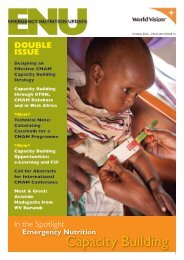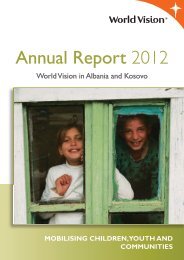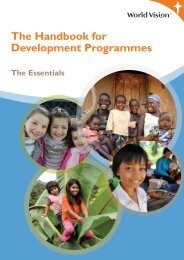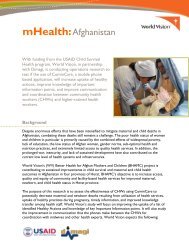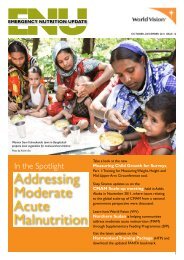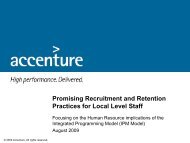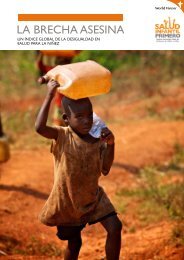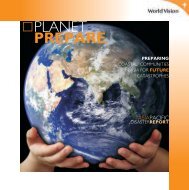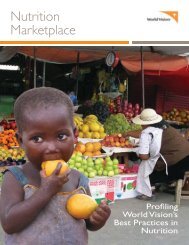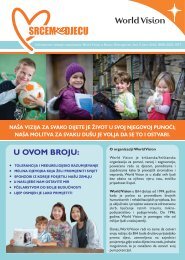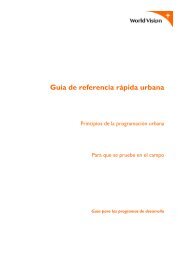the right to inclusive education for children with disabilities
the right to inclusive education for children with disabilities
the right to inclusive education for children with disabilities
Create successful ePaper yourself
Turn your PDF publications into a flip-book with our unique Google optimized e-Paper software.
<strong>the</strong>se <strong>children</strong>, parents would consider <strong>the</strong> institutionalization of <strong>the</strong>ir <strong>children</strong> as <strong>the</strong> sole alternative. Thisexplains <strong>the</strong> increasing number of <strong>children</strong> who attended <strong>the</strong> Institute <strong>for</strong> Students <strong>with</strong> Visual and HearingImpairment until <strong>the</strong> 1990s. Until <strong>the</strong> 1990s, <strong>the</strong> <strong>for</strong>ms that have dominated <strong>the</strong> services, have been thoseof care in specific institutions, disconnected and isolated from o<strong>the</strong>r <strong>children</strong> and <strong>the</strong> community. Themain arguments that underpinned <strong>the</strong>se practices, have been <strong>the</strong> assumption that in this way, <strong>the</strong> work<strong>with</strong> <strong>the</strong>se <strong>children</strong> was more organized, in smaller and more homogeneous groups, and thus conditionswere created <strong>for</strong> a more effective treatment. On <strong>the</strong> o<strong>the</strong>r hand, a lot of criticism was addressed <strong>to</strong> <strong>the</strong>seinstitutions, especially <strong>for</strong> its artificial conditions and <strong>the</strong> isolation <strong>the</strong>y created, and social inadequacy that iscreated <strong>to</strong> <strong>the</strong>se <strong>children</strong> <strong>to</strong> cope <strong>with</strong> real life, <strong>the</strong> lack of positive models, <strong>the</strong> limited incentives, reductionof <strong>the</strong> demands of <strong>the</strong> staff, <strong>the</strong> negative effects of <strong>the</strong>ir stigmatizing etc.So at this stage of development of <strong>education</strong> <strong>for</strong> <strong>children</strong> <strong>with</strong> <strong>disabilities</strong>, <strong>the</strong> most typical way of <strong>the</strong>ir<strong>education</strong>, was <strong>the</strong> special <strong>education</strong>. Separate special <strong>education</strong>, just like o<strong>the</strong>r services <strong>for</strong> people <strong>with</strong><strong>disabilities</strong> and <strong>children</strong> <strong>with</strong> special needs, emerged as an expression of care that society revealed <strong>to</strong>ward<strong>the</strong>m. The medical model of disability, considers disability as an individual pathology, <strong>the</strong>re<strong>for</strong>e defectiveindividuals must be cured through medical intervention which would correct <strong>the</strong> anomaly and help <strong>the</strong>madapt <strong>to</strong> <strong>the</strong> environment. Implementation of <strong>the</strong> medical model in <strong>education</strong> led <strong>to</strong> <strong>the</strong> emergence andspread of special schools and residential institutions <strong>for</strong> <strong>children</strong> <strong>with</strong> <strong>disabilities</strong>. Medicalisation of disability,which gave rise <strong>to</strong> long-term institutionalization, is one of <strong>the</strong> main fac<strong>to</strong>rs of segregation, isolation andexclusion. From it generated all social segregative policies and exclusive practices that on sporadic casescontinue <strong>to</strong> exist till <strong>to</strong>day.Facts and figures on <strong>the</strong> number of students <strong>with</strong> <strong>disabilities</strong>, who arecurrently being educated in special schools in <strong>the</strong> country• In <strong>the</strong> special school of <strong>the</strong> city of Korça during <strong>the</strong> school year 2010-2011 <strong>the</strong>re were enrolled infirst grade 13 <strong>children</strong>.• In <strong>the</strong> special school of <strong>the</strong> city of Vlora currently <strong>the</strong>re are attending 92 <strong>children</strong> (30 females and62 males).• During <strong>the</strong> academic year 2010-2011 <strong>the</strong>re were enrolled 19 first grade <strong>children</strong> and 8 <strong>children</strong>completed <strong>the</strong> school.Despite <strong>the</strong> ef<strong>for</strong>ts of <strong>the</strong> Albanian government and nongovernmental organizations <strong>to</strong> enable <strong>the</strong> inclusionof <strong>children</strong> <strong>with</strong> <strong>disabilities</strong> in <strong>inclusive</strong> schools, <strong>the</strong>re is still a significant number of <strong>children</strong> who receive<strong>the</strong>ir educated in special schools. This is explained by several reasons. Parents have low expectations <strong>for</strong>development and progress of <strong>the</strong>ir <strong>children</strong> and that is why <strong>the</strong>y choose <strong>to</strong> educate <strong>the</strong>ir <strong>children</strong> in specialschools. Ano<strong>the</strong>r reason is <strong>the</strong> high level of poverty and unemployment among families of <strong>children</strong> <strong>with</strong><strong>disabilities</strong>. Conditioned by <strong>the</strong> difficult social-economical fac<strong>to</strong>rs, <strong>the</strong>se families educate <strong>the</strong>ir <strong>children</strong>in special schools because <strong>the</strong>se institutions provide free meals, textbooks and o<strong>the</strong>r school materials.Ano<strong>the</strong>r reason worth mentioning, is <strong>the</strong> lack in regular school’s infrastructure, lack of flexibility of <strong>the</strong>curriculum, inadequacy of knowledge of teachers on how <strong>to</strong> cope <strong>with</strong> this category of <strong>children</strong>, <strong>the</strong> lackof implementation of <strong>the</strong> legal framework <strong>for</strong> <strong>the</strong> <strong>education</strong> of <strong>children</strong> <strong>with</strong> <strong>disabilities</strong>, etc.In 2003, <strong>the</strong> <strong>to</strong>wn of Laç <strong>with</strong> <strong>the</strong> initiative of Caritas France and <strong>the</strong> Education Office of Kurbin District,and <strong>the</strong> support provided by staff of <strong>the</strong> Child Development Center in Tirana, it was opened <strong>the</strong> firstspecial class <strong>with</strong> 15 <strong>children</strong> <strong>with</strong> <strong>disabilities</strong>, in <strong>the</strong> premises of a high school of <strong>the</strong> city. But <strong>the</strong> schoolcommunity was disapproving and biased against <strong>children</strong> <strong>with</strong> <strong>disabilities</strong>. For this reason this class wasmoved in<strong>to</strong> <strong>the</strong> premises of a 9-year school. Currently, in this class, study 13 <strong>children</strong>. Teachers who work<strong>with</strong> <strong>children</strong> <strong>with</strong> <strong>disabilities</strong>, are part of <strong>the</strong> regular institution’s make out. To realize <strong>the</strong> learning process<strong>for</strong> <strong>children</strong> mixed methods of <strong>education</strong>-learning process are applied.The <strong>right</strong> <strong>to</strong> Inclusive Education <strong>for</strong> <strong>children</strong> <strong>with</strong> Disabilities25



